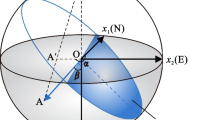Summary
The technique developed uses the spectral signature or Fourier Transform of a signal to gain information about the rock mass. This process enables rock masses to be characterised by observing and quantifying the degree by which discontinuities and other rock mass characteristics preferentially filter the various frequency components of an induced signal. The initial analysis has concentrated on using the technique to investigate the dependence of attenuation spectra on discontinuity characteristics. This has been achieved by correlating statistically significant direct parameters with attenuation spectra from the same rock masses. The preliminary results given in the paper indicate the potential usefulness of the technique for characterising discontinuous rock.
Résumé
La technique qui a été mise au point utilise la signature spectrale ou transformation de Fourier d'un signal, pour obtenir l'information sur la masse rocheuse. Ce procédé permet de caractériser les masses rocheuses par l'observation et la quantification du degré auquel les discontinuités et autres caractères des masses rocheuses filtrent préférenciellement les diverses fréquences qui composent un signal. L'analyse initiale s'est concentrée sur l'emploi de cette technique pour chercher les relations entre spectre d'atténuation et caractères de discontinuité. Le résultat de cette recherche est une corrélation statistique entre paramètres directs significatifs et spectres d'atténuation pour les mêmes masses rocheuses. Les premiers résultats donnés dans cet article font apparaître l'utilité potentielle de cette technique pour caractériser les roches discontinues.
Similar content being viewed by others
References
BARTON N.—LIEN R.—LUNDE J. (1974): Engineering Classification of Rock Masses for the Design of Tunnel Support, Norwegian Geotechnical Institute Technical Report.
BIENIAWSKI Z.T. (1973): Engineering Classification of Jointed Rock Masses. Trans. S. African Inst. Civil Engineers, 15, 12, 335–344.
BORN W.T. (1941): The Attenuation Constant of Earth Materials. Geophysics, 6, 132–148.
DA GAMA C.D. (1971): Studying Rock Fractures by Wave Attenuation Methods. Symp. Soc. Intern. Mécanique des Roches, Nancy, 1–2.
DEARMAN W.R. (1976): Weathering Classification in the Characterisation of Rock: a Revision. Bull. Int. Ass. Engng Geol., No. 13, 123–127.
DUNCAN N. (1966): Excavation Assessments: the Physical and Mechanical Properties of Rock Materials. Muck Shift. Publ. Wks. Dig (Nov.), 60–66.
GOODMAN R. (1976): Methods of Geological Engineering in Discontinuous Rock.
GRAINGER P.—McMANN D.M.—GALLOIS R.W. (1973): The Application of the Seismic Refraction Technique to the Study of the Fracturing of the Middle Chalk at Mundford Norfolk. Géotechnique, 23, No. 2, 219–232.
GUPTA R.R.—BARKHOUDARIAN S.—STEINBERG R.F. (1972): Seismic Determination of Geological Discontinuities of Rapid Excavation. Proc. North American Rapid Excavation and Tunnelling Conf., 217–233.
JOHN K.W. (1970): Civil Engineering Approach to Evaluate the Strength of Regularly Jointed Rock. Proc. 11th Symp. on Rock Mech. (AIME), 69–82.
LAKSHMANAN J. (1971): Seismic Logging: a Means to Investigate Rock Fissuration. Symp. Soc. Inten. Mécanique des Roches, Nancy, 1–20.
LYKOSHIN A.G.—VASCHENKO S.G.—MIKHAILOV A.D. —SAVITCH A.I.—KOPTEV V.J. (1971): Investigation of Rock Jointing by Seismo-Acoustic Methods. Symp. Soc. Intern. Mécanique des Roches, Nancy, 1–19.
McDONAL F.J. et al. (1958): Attenuation of Shear and Compressional Waves in Pierre Shale. Geophysics, 23, 421–439.
MOSSMAN R.W.—HEIM G.G. (1972): Seismic Exploration applied to Unterground Excavation Problems. Proc. N. Amer. Rapid Excavation and Tunnelling Conf., Chicago, 169–191.
NIINI H.—MANUNEN T.(1970): Seismic Soundings as an Indicator of Engineering Geologic Properties of Bedrock in Finland. Proc. 1st Int. Cong. Engng Geol. Paris, 753–761.
ONODERA T.F. (1962): Dynamic Investigation of Foundation Rocks in situ. 5th Symp. on Rock Mechanics, Minnesota, 517–533.
PRIEST S.D.—HUDSON J.A. (1976): Discontinuity Spacing in Rock. Int. Jour. Rock Mech. Min. Sci. & Geomech. Abst. 13, 135–148.
RICKER N. (1944): Wavelet Function and their Polynomials. Geophysics, 9, 314–323.
SCHNEIDER B. (1967): Contribution a l'étude des Massifs de Fondation de Barrages. Trans. du Labor. de Géol. de la Fac. des Sci. de Grenoble, 1–235.
SCOTT J.H.—LEE F.T.—CARROLL R.D.—ROBINSON C.S. (1968): The Relationship of Geophysical Measurements to Engineering and Construction Parameters in the Straight Creek Tunnel Pilot Bore, Colorado, 1–30.
Author information
Authors and Affiliations
Rights and permissions
About this article
Cite this article
Young, R.P., Coffey, J.R. & Hill, J.J. The application of spectral analysis to rock quality evaluation for mapping purposes. Bulletin of the International Association of Engineering Geology 19, 268–274 (1979). https://doi.org/10.1007/BF02600487
Published:
Issue Date:
DOI: https://doi.org/10.1007/BF02600487




